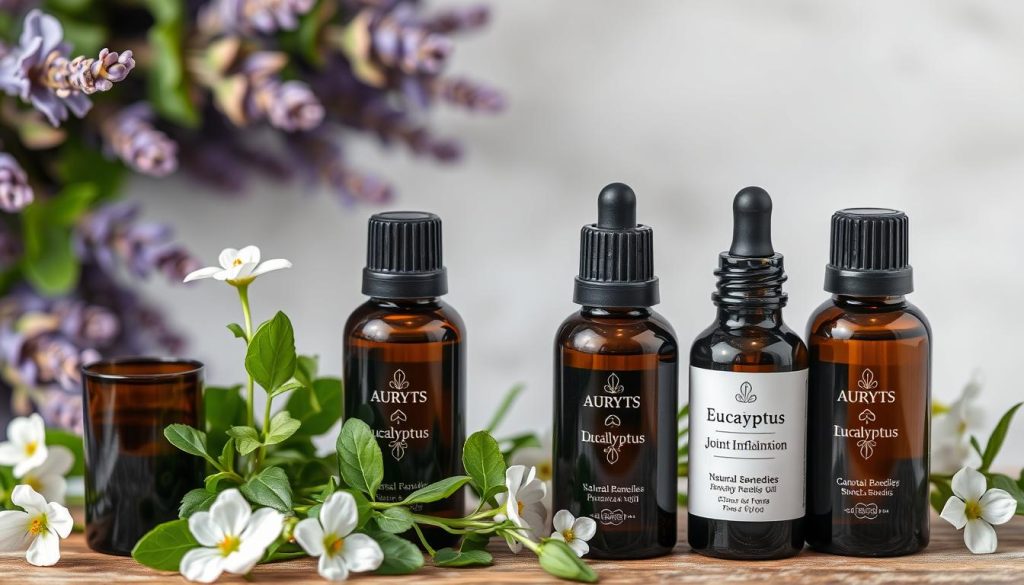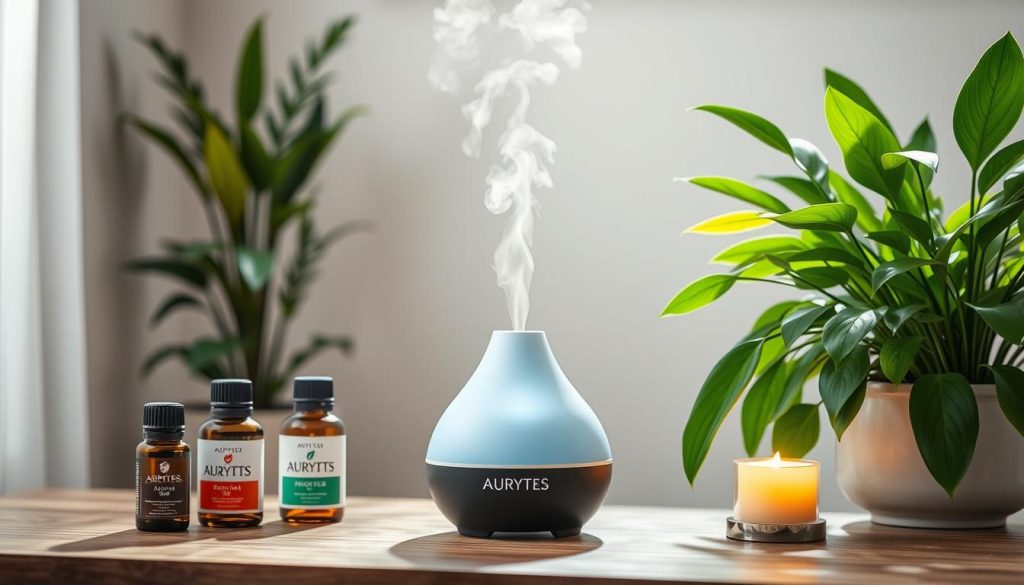Ever thought if essential oils’ soothing scents could ease pain? As more look for natural pain relief, aromatherapy is getting noticed. But does it really help, or is it just a nice smell?
Aromatherapy uses essential oils from plants to help relax and feel better. Studies show some oils might help with pain. This could be a natural way to manage pain, from arthritis to muscle aches.
In this article, we’ll look into how aromatherapy works for pain relief. We’ll see how essential oils can help manage pain naturally. Join us to learn if aromatherapy can really ease discomfort and boost well-being.
Key Takeaways
- Aromatherapy uses essential oils from plants to help relax and relieve pain.
- Certain essential oils might have pain-relieving properties, offering a natural way to manage pain.
- Aromatherapy can help with different types of pain, from long-term conditions to muscle aches.
- Adding aromatherapy to your pain relief plan might offer a natural complement to traditional treatments.
- Understanding how aromatherapy works is key to using essential oils effectively for pain relief.
Understanding Aromatherapy and Its Potential for Pain Relief
Aromatherapy is a way to manage pain naturally. It uses essential oils from plants. These oils have special compounds that can help the body feel better.
By learning about aromatherapy and its oils, you can try it with other pain treatments. This can help you find relief from pain.
Essential oils can be used in different ways. You can put them on your skin, breathe them in, or use them in massages. When you apply them to your skin, they get into your blood and work their magic.
Breathing in these oils can also help. It makes your brain relax and can reduce pain. Using oils in massages can make these benefits even stronger.
Aromatherapy is a gentle, non-invasive way to manage pain. It works in harmony with the body’s natural healing processes, providing a sense of comfort and well-being.
Choosing the right essential oils is key when using aromatherapy for pain. Here are some important things to remember:
- Diluting essential oils in a carrier oil before topical application to avoid skin irritation
- Conducting a patch test before using a new essential oil to check for sensitivity
- Consulting with a qualified aromatherapist or healthcare professional for personalised guidance
- Being aware of potential drug interactions and contraindications
Adding aromatherapy to your pain management can be very helpful. It uses the natural healing power of essential oils. This can help with chronic pain, muscle aches, or joint pain.
How Essential Oils Work to Alleviate Pain
Essential oils have been used for centuries to help with pain. They can ease muscle aches and chronic pain. But how do they work? Let’s look at the science behind their pain-relieving properties and the best ways to use them.
The Science Behind Aromatherapy’s Analgesic Properties
Essential oils contain compounds that affect the body’s pain receptors. This can make pain feel less intense. For example, lavender and peppermint oils have linalool and menthol. These help change how the nervous system handles pain.
Anti-inflammatory oils like eucalyptus and ginger also have powerful compounds. These help reduce swelling and inflammation. By tackling the source of pain, these oils can offer lasting relief and improve health.
Topical Application vs Inhalation: Which Method Is More Effective?
There are two main ways to use essential oils for pain: topical and inhalation. Topical application involves mixing the oil with a carrier oil and rubbing it on the skin. This method targets pain directly.
Inhalation uses the scent of essential oils to relax the mind and body. When inhaled, these scents interact with the brain’s pain centers. This can help reduce stress and anxiety, which can make pain worse.
So, which method is better? It depends on the type of pain and personal preference. Topical application is good for local pain, like muscle soreness. But for widespread pain, inhalation might be more effective.
A study in the Journal of Alternative and Complementary Medicine showed lavender oil inhalation can lessen migraine pain.
Using both topical application and inhalation together might be the best approach. Try different essential oils and methods to see what works best for you.
Top Essential Oils for Pain Management
Several essential oils are great for managing pain through aromatherapy. They have strong analgesic and anti-inflammatory properties. These natural remedies can help with muscle aches, joint discomfort, and chronic pain. Let’s look at three effective essential oils for pain management and how to use them in your self-care routine.
Lavender: A Versatile Oil for Relaxation and Pain Relief
Lavender oil is loved for its gentle and versatile nature. It calms and relaxes, helping with chronic pain stress and tension. It’s good for headaches, menstrual cramps, and general pain. Use lavender oil in a warm bath, mix with a carrier oil for topical use, or inhale it through diffusion.
Peppermint: Cooling and Soothing Properties for Muscle Aches
Peppermint oil is great for muscle aches and pains. Its menthol content numbs the skin, offering quick relief. It’s good for sore muscles, tension headaches, and migraines. Apply peppermint oil topically when diluted or use it in a cold compress for targeted relief.
Eucalyptus: Anti-Inflammatory Effects for Joint Pain
Eucalyptus oil is known for its anti-inflammatory properties. It’s good for joint pain and conditions like arthritis. Its cooling effect reduces muscle soreness and stiffness. Use eucalyptus oil in a warm compress, in a massage blend, or through steam inhalation to open airways and promote well-being.
| Essential Oil | Pain Type | Application Methods |
|---|---|---|
| Lavender | Headaches, menstrual cramps, general aches and pains | Warm bath, topical application (diluted), diffusion |
| Peppermint | Muscle aches, tension headaches, migraine attacks | Topical application (diluted), cold compress |
| Eucalyptus | Joint pain, arthritis, muscle soreness and stiffness | Warm compress, massage blend, steam inhalation |
Remember to dilute essential oils with a carrier oil before applying them to avoid skin irritation. Always do a patch test before using a new essential oil. By using these top essential oils, you can find natural relief and improve your well-being.
Aromatherapy Massage for Muscular Aches and Pains
Aromatherapy massage combines essential oils with massage for pain relief. It targets specific pain areas. This makes it great for those with muscular aches and pains.
Techniques for Incorporating Essential Oils in Massage
There are many ways to use essential oils in massage. One method is mixing a few drops of essential oil with carrier oils like sweet almond or coconut oil. This makes the essential oil safe for the skin while keeping its benefits.
Effective massage techniques for pain include:
- Swedish massage: It’s gentle and relaxing, improving circulation and easing muscle tension.
- Deep tissue massage: It targets deep muscle layers, releasing chronic tension and pain.
- Trigger point therapy: Applying pressure to muscle points helps release knots and pain.

Benefits of Aromatherapy Massage for Chronic Pain Conditions
Aromatherapy massage offers more than just quick pain relief. It’s a holistic approach for managing chronic pain. It has many benefits, including:
- Reduced inflammation: Essential oils like ginger and turmeric can reduce swelling and pain in conditions like arthritis and fibromyalgia.
- Improved circulation: Massage and essential oils together boost blood flow. This delivers oxygen and nutrients to damaged tissues, aiding in healing.
- Stress relief: Chronic pain often comes with stress and anxiety. Aromatherapy massage can help relax, reduce stress, and improve well-being.
“Aromatherapy massage has been a game-changer for my chronic back pain. The combination of soothing essential oils and targeted massage techniques has helped me to manage my pain and improve my quality of life.” – Sarah, chronic pain sufferer
Adding aromatherapy massage to a pain management plan can greatly improve symptoms. It’s a safe, natural, and effective way to ease muscular aches and pains.
| Essential Oil | Benefits for Muscular Aches and Pains |
|---|---|
| Lavender | Relaxes muscles, reduces inflammation, and promotes restful sleep |
| Peppermint | Provides a cooling sensation, alleviates muscle spasms, and improves circulation |
| Marjoram | Eases muscle tension, reduces stiffness, and promotes relaxation |
| Ginger | Warms muscles, reduces inflammation, and alleviates pain |
Aromatherapy as a Complementary Therapy for Neuropathic Pain
Neuropathic pain comes from damage to the nervous system. It’s hard to manage. Conventional treatments like medicines and physical therapy are common. But, complementary therapies like aromatherapy are also helping.
How Essential Oils Can Help Manage Nerve Pain Symptoms
Essential oils have been used for ages to ease pain. For neuropathic pain, some oils are especially helpful. They have natural compounds that protect nerves and ease pain.
- Bergamot: Its calming scent helps with pain and inflammation, making it great for neuropathic pain.
- Geranium: This oil is good for the nervous system, reducing inflammation and helping it heal.
- Chamomile: Known for its soothing scent, chamomile oil helps relax and ease pain.
Best Practices for Using Aromatherapy Alongside Conventional Treatments
Using aromatherapy for neuropathic pain needs careful planning. Always talk to a healthcare professional first. Essential oils are strong, so it’s important to use them right.
Always do a patch test before using a new essential oil to check for skin sensitivity, and never apply undiluted oils directly to the skin.
To get the most from aromatherapy for nerve pain, follow these tips:
| Practice | Description |
|---|---|
| Dilution | Dilute essential oils in a carrier oil, such as coconut or jojoba oil, before applying topically to the affected area. A safe dilution ratio is typically 2-3 drops of essential oil per teaspoon of carrier oil. |
| Inhalation | Add a few drops of essential oil to a diffuser or inhale directly from the bottle for quick relief. This method allows the aroma to stimulate the olfactory system and promote relaxation. |
| Consistency | Use aromatherapy consistently as part of your daily routine to experience the cumulative benefits of essential oils for nerve pain management. |
By adding aromatherapy to your treatment plan, you can use essential oils to manage nerve pain. Always listen to your body and work with your healthcare provider. This way, you can improve your life quality.
Aromatherapy for Arthritis and Joint Pain Relief
Arthritis and joint pain affect millions worldwide. Many turn to aromatherapy for relief, alongside traditional treatments. Aromatherapy uses essential oils from plants to manage arthritis by reducing inflammation and stiffness.
Essential oils are concentrated plant extracts with healing properties. They can lessen inflammation, ease muscle tension, and relax the body. The best way to use them depends on the oil and the person.

Essential Oil Blends That Target Inflammation and Stiffness
Some essential oils are great for arthritis because they fight inflammation and pain. Key oils include:
- Ginger: It’s warm and fights inflammation, easing joint pain and stiffness.
- Turmeric: Its curcumin fights inflammation, reducing swelling in joints.
- Frankincense: It has boswellic acids that reduce inflammation and pain in arthritis.
- Lavender: Known for relaxation, it also fights inflammation and pain in joints.
Mixing these oils can make them even more effective. For example, ginger and turmeric together fight inflammation well. Lavender and frankincense can help with pain and stress.
Incorporating Aromatherapy Into Your Arthritis Management Plan
There are many ways to use aromatherapy for arthritis. Here are a few:
- Topical application: Mix essential oils with a carrier oil and massage them on joints and muscles.
- Aromatherapy baths: Add essential oils to warm baths for joint relief and relaxation.
- Diffusion: Use a diffuser to spread the aroma of anti-inflammatory oils in your space.
Working with an aromatherapist or healthcare provider is key. They can help choose the right oils and how to use them. Always check for any interactions with medications and do a patch test for sensitivities.
Aromatherapy has been a game-changer in managing my arthritis symptoms. By incorporating essential oils like ginger and turmeric into my daily routine, I’ve experienced less pain and stiffness in my joints, allowing me to enjoy a more active lifestyle.
Adding aromatherapy to your arthritis plan can help reduce inflammation and pain. It’s important to listen to your body and start slowly. Adjust as needed based on how you respond.
A Holistic Approach to Pain Control with Aromatherapy
Managing pain can be easier with a holistic approach that includes aromatherapy. This method looks at the mind-body connection. It uses the power of multiple therapies to help you feel better.
An integrative approach combines aromatherapy, mind-body techniques, and lifestyle changes. Practices like meditation and deep breathing help manage pain emotionally and mentally. Essential oils add to the physical relief.
The power of aromatherapy lies in its ability to promote relaxation, reduce stress, and enhance overall well-being, all of which contribute to more effective pain management.
To get the most from aromatherapy for pain, try these mind-body techniques:
- Mindfulness meditation: Focus on now and notice your thoughts and feelings without judgment. This brings calm and lowers pain.
- Deep breathing exercises: Slow breathing relaxes muscles, lowers stress, and boosts well-being. This makes pain easier to handle.
- Guided imagery: Imagine peaceful scenes to distract from pain and relax.
Lifestyle changes are also key in managing pain. Regular exercise, a balanced diet, and stress management improve pain control and health.
By using aromatherapy, mind-body techniques, and lifestyle changes, you can find effective pain relief. This approach leads to better, lasting pain management.
Precautions and Safety Considerations When Using Essential Oils for Pain
Aromatherapy is a natural way to manage pain. But, it’s vital to be safe when using essential oils. Knowing about side effects, drug interactions, and how to dilute them helps. This way, you can enjoy the benefits of aromatherapy without risks.
Potential Side Effects and Interactions with Medications
Even though essential oils come from nature, they can still cause problems. Skin irritation and allergic reactions are common. Some oils might also affect how medicines work.
Always talk to an aromatherapist or doctor before using essential oils for pain. This is especially true if you have health issues or take medicines.
Importance of Dilution and Proper Application Techniques
Diluting essential oils is key to safe use. They are very strong and can irritate skin if not mixed right. Always mix them with a carrier oil like coconut or jojoba before applying.
Follow the right dilution ratios and do a patch test before using them widely. Avoid sensitive areas and wash your hands after handling oils. By following these steps, you can use aromatherapy safely for pain relief.
